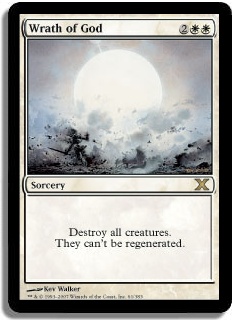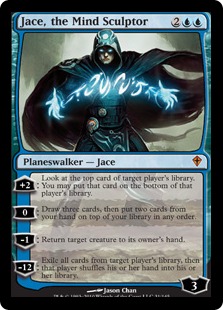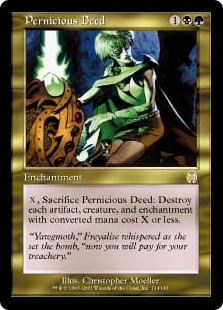I said I would talk about card economy this week, and I will, but I’ll save the walkthrough of the second game for later. Let’s not waste any time—this is gonna be a long one.
Allow me to introduce you to the most influential card in the history of Magic: The Gathering:

You’ve probably met this little piece of work here, but I doubt many of you have actually stopped to think about the impact that this card has had and the impact that it continues to have today. You want to talk about card advantage and card economy? The discussion starts here. You want to talk about tempo? The discussion starts here. You want to talk about card influence? The discussion starts here. For the entire life of the game, this card has been the baseline for an entire group of cards and the cornerstone of not only archetypes, but entire strategies. To understand Wrath of God is to understand the system of Magic itself. I’ve already written one article on the card here, and this will be number two—just devoted to this card. Assuming I continue writing for a while, there will be more. It’s only fitting for a card this important.
What Is Card Economy?
Before we attempt to analyze something, we have to understand the goal of our analysis. In this case, that means defining card economy. Card economy is the management of your existing cards. The question is: How is it related to a fundamental concept everyone is familiar with—card advantage?
Comparing cards to money here makes for a good example. Having card advantage is like earning a lot of money. Card economy is managing how you spend or invest your money. Both are necessary to be successful (wealthy). You can earn a lot of money and still go broke very quickly if you don’t manage it well. There are many examples of professional athletes who make millions over the course of their short careers and go broke very soon after their playing days end because they don’t manage their money well. In a similar vein, you can draw a lot of cards and generate a lot of card advantage over the course of the game and still lose . . . especially if you don’t use your cards well. That’s why card economy is important.
There are two major parts of taking advantage of a card—the threat of the card and the actual casting of the card. They are distinct, and both can be used advantageously. Thus, both are important parts of card economy. Let’s look at these two parts separately.
Using Wrath of God
Before we look at threatening the card, we have to understand what the card actually does when it’s cast. Let’s explore the functionality of Wrath of God when you actually put it on the stack.
Wrath of God has three basic functions:
- Generate card advantage
- Buy time
- Kill a creature
People, myself included, underestimate Option 3 all the time, it seems. I wonder how many times someone has begrudgingly said, “I guess I’ll snipe with Wrath,” when that is, in fact, the card’s primary function. Wrath of God’s primary function is to deal with creatures that are threats to you by removing them from play. It’s that simple.
Wrath’s secondary function is probably the one most people are familiar with: generating card advantage. Whenever Wrath takes more than a single creature with it, it’s generating card advantage. The end result of this is that most people consider Wrath a source of card advantage, just like Concentrate, Fact or Fiction, or other similar spells. This is true, but it is only one among the many facets of Wrath of God.
Another main function of Wrath is to relieve pressure on the board and buy time. A creature that is destroyed must be replaced if a player wants to continue applying pressure on his opponent. Wrath destroys all creatures, and thus buys the player playing it some relief from the pressure of a creature-based assault. The respite obviously only lasts until his opponent is able to replace the threats, but often, that is enough time to mount another defense.
When Wrath’s three abilities intersect, they allow the card to control both the board and the flow of the game.
In order to use these abilities property, you need to take advantage of your opponent’s fears. Because your opponent is afraid to put himself in a situation in which he is too far behind, just the threat of putting him in that situation (the threat of Wrath) can be extremely effective. If you threaten Wrath of God on the proper front (whether it is tempo, card advantage, or just removal), you can effectively deny your opponent actions based on how afraid he is of the card. This is how the various abilities and properties of the card intersect.
Threatening Wrath of God
The primary function of threatening Wrath of God is to buy time. The basic principle is to use the effectiveness of Wrath to prevent your opponent from playing creatures. Often, simply by showing your opponent your ability to Wrath, you can keep a creature off the board and cause a beneficial situation for yourself.
Consider the following situation:
Your opponent is playing a R/G deck with beefy creatures and enough burn to make those creatures troublesome. He has Jungle Lion and Garruk's Companion in play and a Leatherback Baloth in hand. You are playing W/U control, and you’ve just played your third land. Your hand includes Swords to Plowshares, Wrath of God, and Concentrate.
In this situation, you have a line of play available to you which takes advantage of Wrath of God as a threat without actually using the card. If you allow your opponent to hit you with Garruk's Companion and Jungle Lion for 5, he might not follow it up with the powerful 3-drop. Let’s see how the threat of Wrath of God intersects with your use of Swords to Plowshares in this situation. You have three real options:
- You can Plow the Garruk's Companion during combat.
- You can Plow the Garruk's Companion at the end of the turn.
- You can Plow neither creature and play Wrath.
If you Plow the Garruk's Companion during combat, your opponent is very likely to determine whether he has sufficient pressure on the board and thus commit the Leatherback Baloth, forcing you to Wrath on your next turn. If he has another big creature post-Wrath, you may not have time to play your Concentrate. A similar situation evolves if you Plow neither creature and play Wrath. You will most likely be forced to plow his Leatherback Baloth, and if he has an additional creature to follow up, it could be bad times.
However, if you plow the Garruk's Companion at the end of the turn, you have taken 3 damage to buy yourself into a situation in which all your opponent can do on his next turn is hit you with Jungle Lion. This will drop you to 11, but you will have purchased the ability to play Concentrate during that window. If your opponent follows up your Concentrate with Leatherback Baloth, you can simply turn around and play Wrath, clearing the board, while already having played Concentrate.
In effect, you have played the following card when compared to your previous situation: Pay 3 life, draw three cards. That seems like a fairly good trade.
This line of play is only possible if your opponent considers the potential threat of Wrath of God. The only reason he would decline to commit the Leatherback Baloth to the board is if he decides that Wrath is a threat. The reason is simple: If he commits the Baloth and you do have the Wrath, he will lose big. His Baloth will have been completely ineffective and you will be up a card (the Swords).
Now, this is a situation in which you actually do have the Wrath, but you can make the same play even if you don’t, and there are situations in which you should do so. Even if you don’t have the Wrath, you could draw it off of the Concentrate. Your opponent had the opportunity to punish you by committing his Leatherback Baloth to the board, but the threat of Wrath of God was sufficient to stop that, thus buying you time to Concentrate and draw into the actual card.
It’s important to note that threatening this type of play is a huge part of Magic. The reason this is possible is that Magic is a game of imperfect information. Your opponent lacks knowledge of your hand, and you can use that to your advantage. This is an absolutely critical part of understanding how to play the card.
Putting It All Together
The other thing to realize with Wrath is that it is not the only component of your defensive suite. It may be the keystone, but it isn’t the entire arch. The example above showcases that beautifully. In that example, Swords to Plowshares supports Wrath of God and makes the card more effective. Historically, this has been among the greatest strengths of spells and the primary reason that creatures—as a whole—have the worst card type. There are a number of exceptions, of course, but overall, creatures are the weakest card type.
Creatures have a fundamental weakness: the two numbers in their lower-right-hand corners. Their primary advantage—the ability to attack and block—is actually a hindrance quite frequently. Note that the vast majority of the best creatures in the history of Magic do not need to attack or block to be effective. These creatures are played primarily for their other abilities. The reason is that it’s difficult for a creature, the strength of which is combat, to be surprising in any sense. Because it is played at sorcery speed, you can’t really threaten your opponent with it. It’s sort of like going into a fight with a hundred-pound rock as your weapon. Sure, it might look impressive, but in the end, it’s not effective because it’s never going to connect. The threat level to your opponent is heavily diminished because your weapon of choice is highly predictable.
This predictability is the single greatest weakness of creatures. Instants and sorceries, on the other hand, are more often unpredictable. You don’t know exactly when your opponent is going to cast these spells, so you have to prepare for multiple contingencies. This slows you down and gives your opponent openings to attack you. This is exactly the sort of thing that Wrath enables: counter-play.
The Next Step
As far Magic is concerned, there are two styles of play: proactively versus reactively. Most people, when they first start playing Magic, build proactive decks. They build their decks to accomplish something—whether it’s to find a specific combination of cards, to mill their opponents out, or to deal 20 damage as quickly as possible . . . but the specific plan is irrelevant. What matters is that a proactive deck has a singular plan that it’s actively trying to execute.
The hardest jump for most players to make is the jump from playing proactive decks to playing reactive decks. This is because reactive decks require you to not only deal with the cards your opponent is presenting, but his game plan as well. In other words, you have to be able to predict what your opponent is likely to do next so that you can plan out your future turns. Playing a reactive deck requires you to be able to constrain your opponent’s options and develop your own at the same time.
Wrath of God is effectively the first level in this type of strategy. It’s the cornerstone of this type of thought process, and it’s absolutely fundamental to understanding how to interact with an opponent’s thought process and not just what he is actually doing. If you want to become better as a Magic player and you want to better understand how to play reactively, learn to play Wrath of God first. Learn how to use both levels of play that Wrath of God enables.
But it doesn’t end there. The idea of controlling the game by controlling information and options goes further. Let me present you with the second level:

I believe many of you have met Jace before—probably during his rampage across Standard and Extended ever since he was printed in Worldwake. The primary aspects that allow Jace to control information and constrain your opponent’s options are his −1 and +2 abilities. The combination of Unsummon and Fatesteal allows you to affect your opponent’s ability to execute his plans . . . just like Wrath of God does.
So, what does Jace do that Wrath of God doesn’t? Jace provides you with a permanent means of controlling the game’s flow and information. It lasts as long as Jace, the Mind Sculptor is on the table. Jace possesses the same two levels of threat that Wrath does, except that it does so in a much more connected and fluid manner. It is important to take advantage of all four of Jace’s abilities to use him to his maximum potential, and learning to do this is another step on the learning curve toward utilizing information and thought processes as a weapon. But Jace, the Mind Sculptor has a fundamental weakness: In order for you to fully realize his effect, you have to expend additional mana and the cards that he is helping you draw; so, he isn’t the ultimate in this paradigm of controlling information, options, and thought processes.
So, what’s the third level? What’s the ultimate goal? Who sits at the top of the chain? Well, take a look:

Pernicious Deed is unlike any other card ever printed in the history of Magic. Unlike Jace, the Mind Sculptor, Pernicious Deed requires no investment of time or mana to control how your opponent is able to act. Pernicious Deed simply sits there and requires that your opponent take it into account for all current and future actions. It is the only card in the history of Magic that has a threat of a threat. You can threaten to threaten Deed, which is something completely unique to this card.
If you really want to understand how to play reactively, you have to understand how to manage your cards, and the skill central to that ability is managing your opponent’s options and thought processes. There are many cards that can do this, but Wrath of God, Jace, the Mind Sculptor, and Pernicious Deed are by far the three strongest.
If you would like me to talk about the other two cards in more depth, please comment and let me know.
Chingsung Chang
Conelead most everywhere and on MTGO
Khan32k5 at gmail dot com























